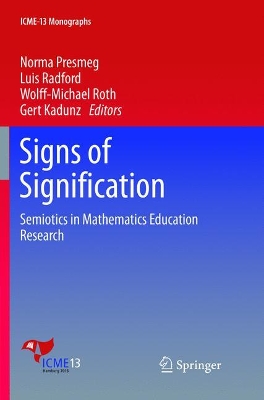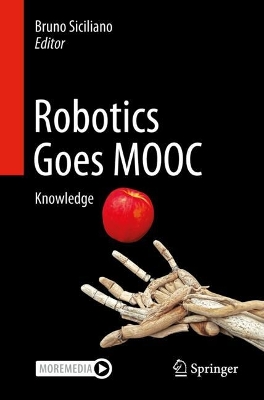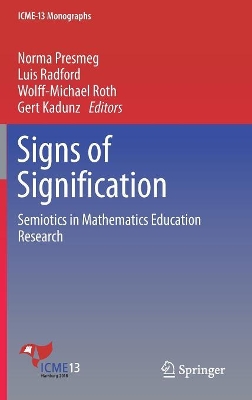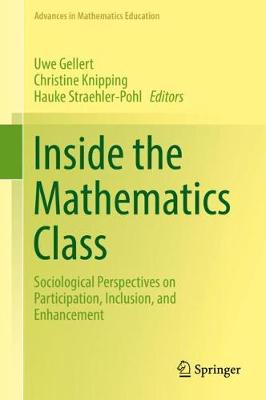Signs of Signification
 -15%
portes grátis
-15%
portes grátis
Signs of Signification
Semiotics in Mathematics Education Research
Kadunz, Gert; Presmeg, Norma; Radford, Luis; Roth, Wolff-Michael
Springer International Publishing AG
06/2019
372
Mole
Inglês
9783319889160
15 a 20 dias
581
Descrição não disponível.
Chapter 1. Introduction. The editors.- Section 1: Sociocultural perspectives on semiosis.- Chapter 1. Introduction to Section 1.- Chapter 2. Semiosis and subjectification: The classroom constitution of mathematical objects.- Chapter 3. Birth of signs: A (Spinozist-Marxian) materialist approach.- Chapter 4. Relating computational Cartesian graphs to a real motion: An analysis of high school students' activity.- Chapter 5. Joint attention in resolving the ambiguity of different presentations: A dual eye-tracking study of the teaching-learning process.- Chapter 6. Attention catching: Connecting the space of joint action and togethering.- Section 2: Language and text orientations.- Introduction to Section 2.- Chapter 7. A matter of translation.- Chapter 8. Using social semiotics to explore institutional assumptions about mathematics students and teachers.- Chapter 9. Semiotics, epistemology, and mathematics.- Chapter 10. A semiotic-conceptual analysis of conceptual development in learningmathematics.- Section 3: Peircean semiotics, including semiotic chaining and representations.- Introduction to Section 3.- Chapter 11. Adalira Saenz-Ludlow: Iconicity and diagrammatic reasoning in meaning-making.- Chapter 12. Semiotic representations: A study of dynamic figural register.- Chapter 13. Progressive visualization tasks and semiotic chaining for mathematics teacher preparation: Towards a conceptual framework.- Chapter 14. Primary teachers' semiotics praxis: Windows into the handling of division tasks.- Section 4: Semiotic resources including gesturing and tools.- Introduction to Section 4.- Chapter 15. Gradual change of perception: Signs, tools, and meaning-making of fractions.- Chapter 16. On the role of gestures for the descriptive analysis of 'Grundvorstellungen': A case of linear functions.- Chapter 17. Diagramming and gesturing during mathematizing: Kinesthetic and haptic interactions support mathematical ideation.- Chapter 18. Objectifying the inclusion relationshipof quadrilaterals in a synchronic-interactive and collaborative computer supported environment.- Chapter 19. Discussion and conclusions.
Este título pertence ao(s) assunto(s) indicados(s). Para ver outros títulos clique no assunto desejado.
semiotics;semiosis;mathematical sign systems;mathematical generalization;epistemology;semiotic chaining;representations;teaching mathematics;learning mathematics;learning and instruction
Chapter 1. Introduction. The editors.- Section 1: Sociocultural perspectives on semiosis.- Chapter 1. Introduction to Section 1.- Chapter 2. Semiosis and subjectification: The classroom constitution of mathematical objects.- Chapter 3. Birth of signs: A (Spinozist-Marxian) materialist approach.- Chapter 4. Relating computational Cartesian graphs to a real motion: An analysis of high school students' activity.- Chapter 5. Joint attention in resolving the ambiguity of different presentations: A dual eye-tracking study of the teaching-learning process.- Chapter 6. Attention catching: Connecting the space of joint action and togethering.- Section 2: Language and text orientations.- Introduction to Section 2.- Chapter 7. A matter of translation.- Chapter 8. Using social semiotics to explore institutional assumptions about mathematics students and teachers.- Chapter 9. Semiotics, epistemology, and mathematics.- Chapter 10. A semiotic-conceptual analysis of conceptual development in learningmathematics.- Section 3: Peircean semiotics, including semiotic chaining and representations.- Introduction to Section 3.- Chapter 11. Adalira Saenz-Ludlow: Iconicity and diagrammatic reasoning in meaning-making.- Chapter 12. Semiotic representations: A study of dynamic figural register.- Chapter 13. Progressive visualization tasks and semiotic chaining for mathematics teacher preparation: Towards a conceptual framework.- Chapter 14. Primary teachers' semiotics praxis: Windows into the handling of division tasks.- Section 4: Semiotic resources including gesturing and tools.- Introduction to Section 4.- Chapter 15. Gradual change of perception: Signs, tools, and meaning-making of fractions.- Chapter 16. On the role of gestures for the descriptive analysis of 'Grundvorstellungen': A case of linear functions.- Chapter 17. Diagramming and gesturing during mathematizing: Kinesthetic and haptic interactions support mathematical ideation.- Chapter 18. Objectifying the inclusion relationshipof quadrilaterals in a synchronic-interactive and collaborative computer supported environment.- Chapter 19. Discussion and conclusions.
Este título pertence ao(s) assunto(s) indicados(s). Para ver outros títulos clique no assunto desejado.







